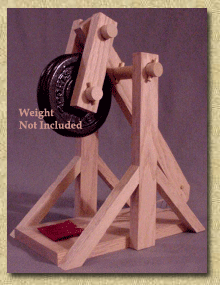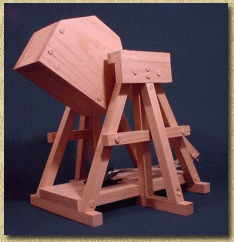|
|
Leonardo da Vinci
Leonardo's Life and Work
Leonardo da Vinci was born on April 15 1452 in the small
village of Vinci, just outside Florence Italy. The illegitimate son of
a Florentine notary and a peasant woman, Leonardo was raised and educated
by his father.

While very young Leonardo showed an intense interest in nature and
an extraordinary talent for drawing and painting. His father, Ser Piero,
was so impressed with young Leonardo's sketches, he showed them to painter
Andrea del Verrocchio who took Leonardo as an apprentice.
Under Andrea, Leonardo apprenticed in painting and sculpture, but was
also fascinated with mechanics and architecture. His genius soon became
apparent to his master. Although he was admitted into the Painter's Guild
in 1472, Leonardo continued his apprenticeship until 1477 when he struck
out on his own.
Leonardo considered himself a student of his art and experimented tirelessly
with light and shadow to perfect the 3 dimensional quality of his painting.
His interests were broad and while working as a painter in Florence began
to devise and sketch hydraulic and military
machinery.
 In
1482, Leonard traveled to Milan to seek work as a military engineer. There,
he met with the Duke of Milan and secured the position of "Painter and
Engineer for The Duke". In Milan Leonardo set up shop where he worked on
studies ranging from painting and sculpture to architecture, powered flight,
urban design, fortifications, catapult
, trebuchet and powder based artillery
and other weapons of war. He also continued
his study of geometry and perspective, which lead to his discovery of several
geometric methods. In
1482, Leonard traveled to Milan to seek work as a military engineer. There,
he met with the Duke of Milan and secured the position of "Painter and
Engineer for The Duke". In Milan Leonardo set up shop where he worked on
studies ranging from painting and sculpture to architecture, powered flight,
urban design, fortifications, catapult
, trebuchet and powder based artillery
and other weapons of war. He also continued
his study of geometry and perspective, which lead to his discovery of several
geometric methods.
It was in Milan Leonardo began his study of anatomy and produced his
famous
notebooks containing meticulously sketches of his studies. These notebooks,
or codices, as later assembled, covered four main areas of study: painting,
architecture, the elements of mechanics and human anatomy.
In 1499, Leonardo left Milan. For the next 16 years, he traveled through
Italy, working as a military architect and engineer, painter and sculptor
and continuing his anatomic studies. In 1503, Leonardo started one of his
most famous works, the Mona Lisa .
In 1566, Leonardo accepted the title of "Premier Painter and Engineer
and Architect of the King" by France's King Francis the First. Leonardo
moved to Amboise, France where he continued his studies and teaching despite
suffering a paralysis of his right hand.
Leonardo da Vinci died on May 2, 1519 in Cloux, France.
Click on the images below to learn more
about Leonardo
|
Save up to 50% with Multi-Plan Deals
|
| 2 Plans $19.95 FREE Shipping
- Save Over 30%
U.S. Orders Only |
|
| Do It Yourself Working Model Trebuchet Kit |

|
 Trebuchet
Kit
Trebuchet
Kit
Item
#TK
|
$75.00
Free
Shipping
U.S. Orders Only |

|
The trebuchet kit includes fully precut and drilled
frame parts, pins and axles, sling cord and sewn pouch, projectiles and
fully illustrated assembly and firing instructions.
Unlike the flimsy, snap together plywood trebuchet
kits, this all hardwood trebuchet kit does not require additional cutting,
trimming or shaping.
This DIY Trebuchet Kit requires only white carpenter's
glue and a few bar clamps (not included) to assemble.
Read
More > |
| Fully Assembled Working Model Trebuchet |

|

daVinci Trebuchet
Item # T4
|
$299.00
Free
Shipping
U.S. Orders Only
|

|
Inspired by the great war machines and siege catapults of Leonardo da Vinci
, this all Red Oak
hardwood trebuchet features
an open counterweight cabinet for range and trajectory adjustment.
Fire with an empty counterweight for indoor use, or add weight (nuts,
bolts, scrap lead, iron or steel, sand, or small rocks not included)
for increased range.
Individually crafted from cabinet-grade red oak, the da Vinci Trebuchet
stands 14 inches tall in the cocked position, 24 inches tall in the fired
position and will hurl a projectile up to 60 feet. Includes six projectiles
and fully illustrated instructions.
Read More > |
Leonardo da Vinci Leonardo's Life and Work |